Macroeconomics: Analysis of Investment in China by Australian Company
VerifiedAdded on 2021/05/31
|41
|10685
|409
Report
AI Summary
This report examines the macroeconomic factors that influence long-term investment decisions, using the potential investment of the Australian mining giant BHP Billiton in China as a case study. The analysis considers various macroeconomic variables, including the general business environment, economic growth and business cycles, unemployment, average wage rates, inflation, real interest rates, domestic credit to the private sector, government expenditure on infrastructure, taxation policy, exchange rates, and the impact of the global financial crisis. The report evaluates China's suitability as an investment destination based on these factors, highlighting China's strong trade relations with Australia, its favorable business environment improvements, and its ongoing economic growth, while also acknowledging the impact of slower growth rates and the need to navigate complex economic dynamics. The conclusion offers recommendations based on the macroeconomic analysis.
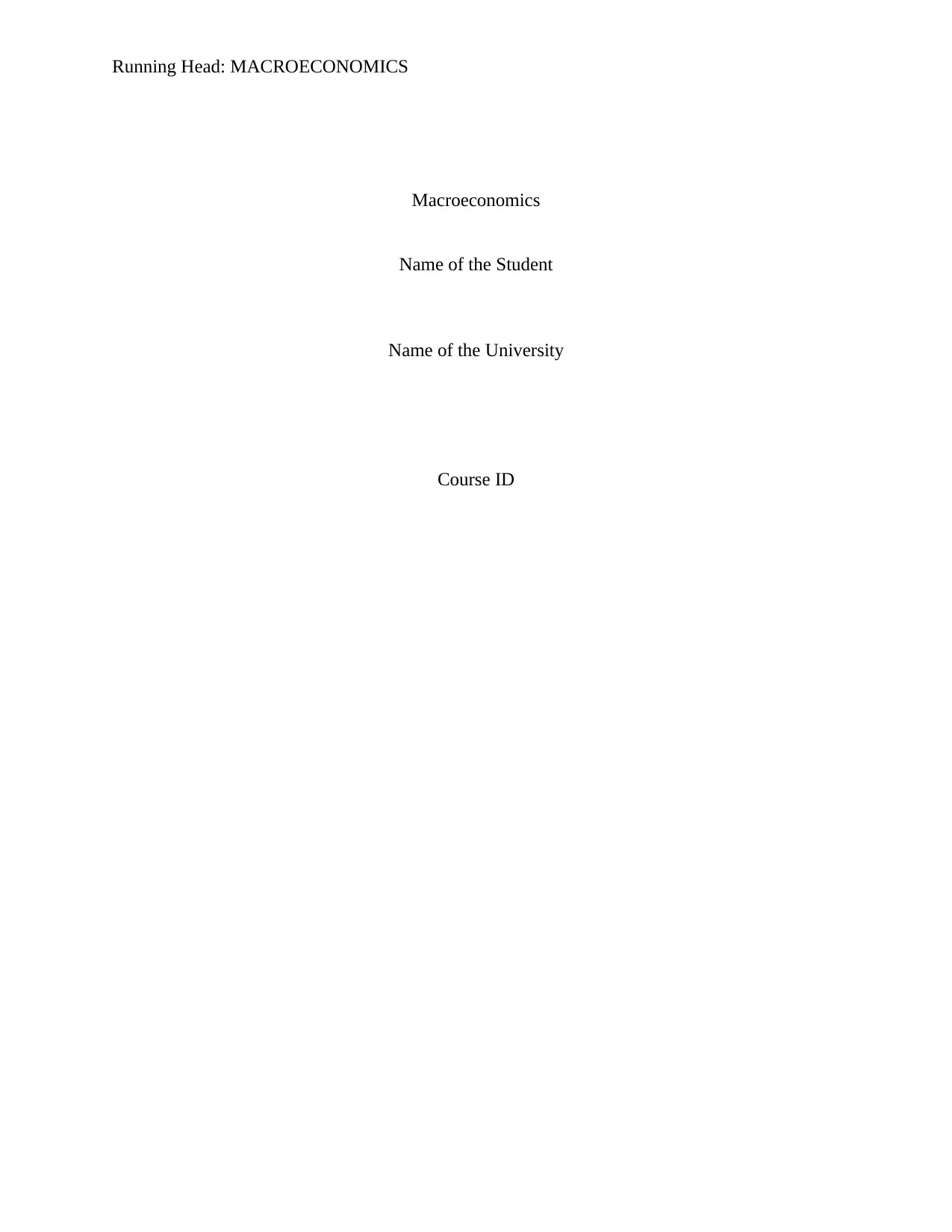
Running Head: MACROECONOMICS
Macroeconomics
Name of the Student
Name of the University
Course ID
Macroeconomics
Name of the Student
Name of the University
Course ID
Paraphrase This Document
Need a fresh take? Get an instant paraphrase of this document with our AI Paraphraser
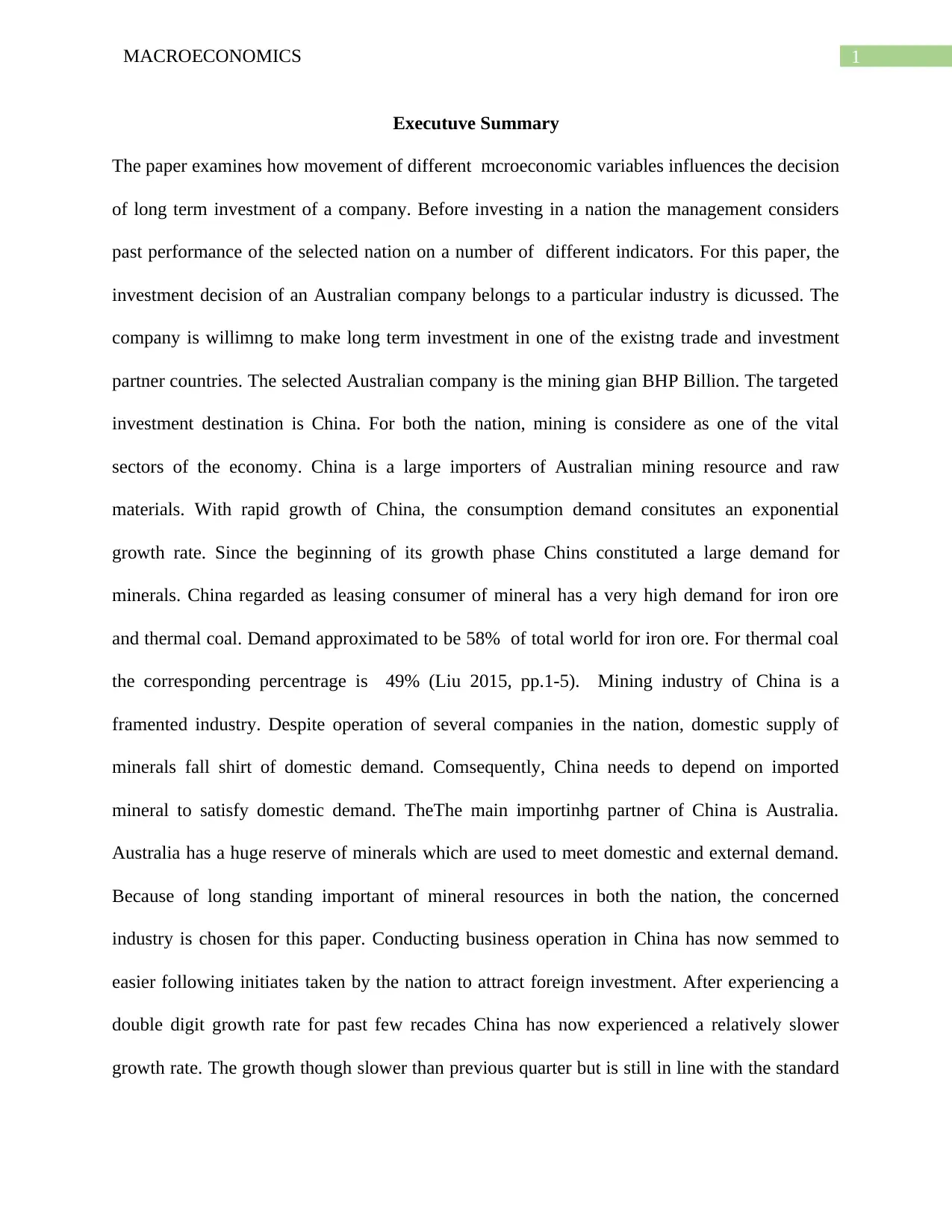
1MACROECONOMICS
Executuve Summary
The paper examines how movement of different mcroeconomic variables influences the decision
of long term investment of a company. Before investing in a nation the management considers
past performance of the selected nation on a number of different indicators. For this paper, the
investment decision of an Australian company belongs to a particular industry is dicussed. The
company is willimng to make long term investment in one of the existng trade and investment
partner countries. The selected Australian company is the mining gian BHP Billion. The targeted
investment destination is China. For both the nation, mining is considere as one of the vital
sectors of the economy. China is a large importers of Australian mining resource and raw
materials. With rapid growth of China, the consumption demand consitutes an exponential
growth rate. Since the beginning of its growth phase Chins constituted a large demand for
minerals. China regarded as leasing consumer of mineral has a very high demand for iron ore
and thermal coal. Demand approximated to be 58% of total world for iron ore. For thermal coal
the corresponding percentrage is 49% (Liu 2015, pp.1-5). Mining industry of China is a
framented industry. Despite operation of several companies in the nation, domestic supply of
minerals fall shirt of domestic demand. Comsequently, China needs to depend on imported
mineral to satisfy domestic demand. TheThe main importinhg partner of China is Australia.
Australia has a huge reserve of minerals which are used to meet domestic and external demand.
Because of long standing important of mineral resources in both the nation, the concerned
industry is chosen for this paper. Conducting business operation in China has now semmed to
easier following initiates taken by the nation to attract foreign investment. After experiencing a
double digit growth rate for past few recades China has now experienced a relatively slower
growth rate. The growth though slower than previous quarter but is still in line with the standard
Executuve Summary
The paper examines how movement of different mcroeconomic variables influences the decision
of long term investment of a company. Before investing in a nation the management considers
past performance of the selected nation on a number of different indicators. For this paper, the
investment decision of an Australian company belongs to a particular industry is dicussed. The
company is willimng to make long term investment in one of the existng trade and investment
partner countries. The selected Australian company is the mining gian BHP Billion. The targeted
investment destination is China. For both the nation, mining is considere as one of the vital
sectors of the economy. China is a large importers of Australian mining resource and raw
materials. With rapid growth of China, the consumption demand consitutes an exponential
growth rate. Since the beginning of its growth phase Chins constituted a large demand for
minerals. China regarded as leasing consumer of mineral has a very high demand for iron ore
and thermal coal. Demand approximated to be 58% of total world for iron ore. For thermal coal
the corresponding percentrage is 49% (Liu 2015, pp.1-5). Mining industry of China is a
framented industry. Despite operation of several companies in the nation, domestic supply of
minerals fall shirt of domestic demand. Comsequently, China needs to depend on imported
mineral to satisfy domestic demand. TheThe main importinhg partner of China is Australia.
Australia has a huge reserve of minerals which are used to meet domestic and external demand.
Because of long standing important of mineral resources in both the nation, the concerned
industry is chosen for this paper. Conducting business operation in China has now semmed to
easier following initiates taken by the nation to attract foreign investment. After experiencing a
double digit growth rate for past few recades China has now experienced a relatively slower
growth rate. The growth though slower than previous quarter but is still in line with the standard
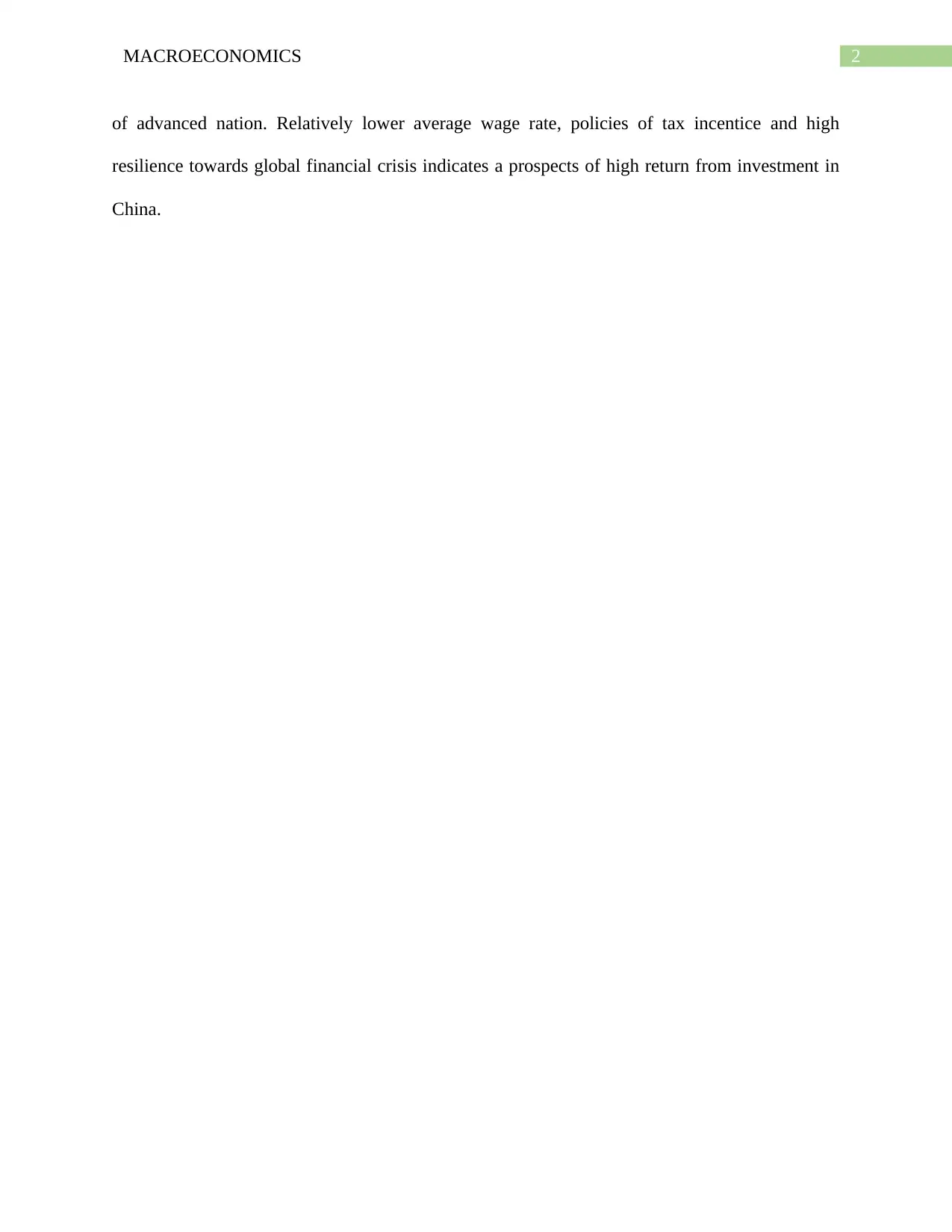
2MACROECONOMICS
of advanced nation. Relatively lower average wage rate, policies of tax incentice and high
resilience towards global financial crisis indicates a prospects of high return from investment in
China.
of advanced nation. Relatively lower average wage rate, policies of tax incentice and high
resilience towards global financial crisis indicates a prospects of high return from investment in
China.
⊘ This is a preview!⊘
Do you want full access?
Subscribe today to unlock all pages.

Trusted by 1+ million students worldwide
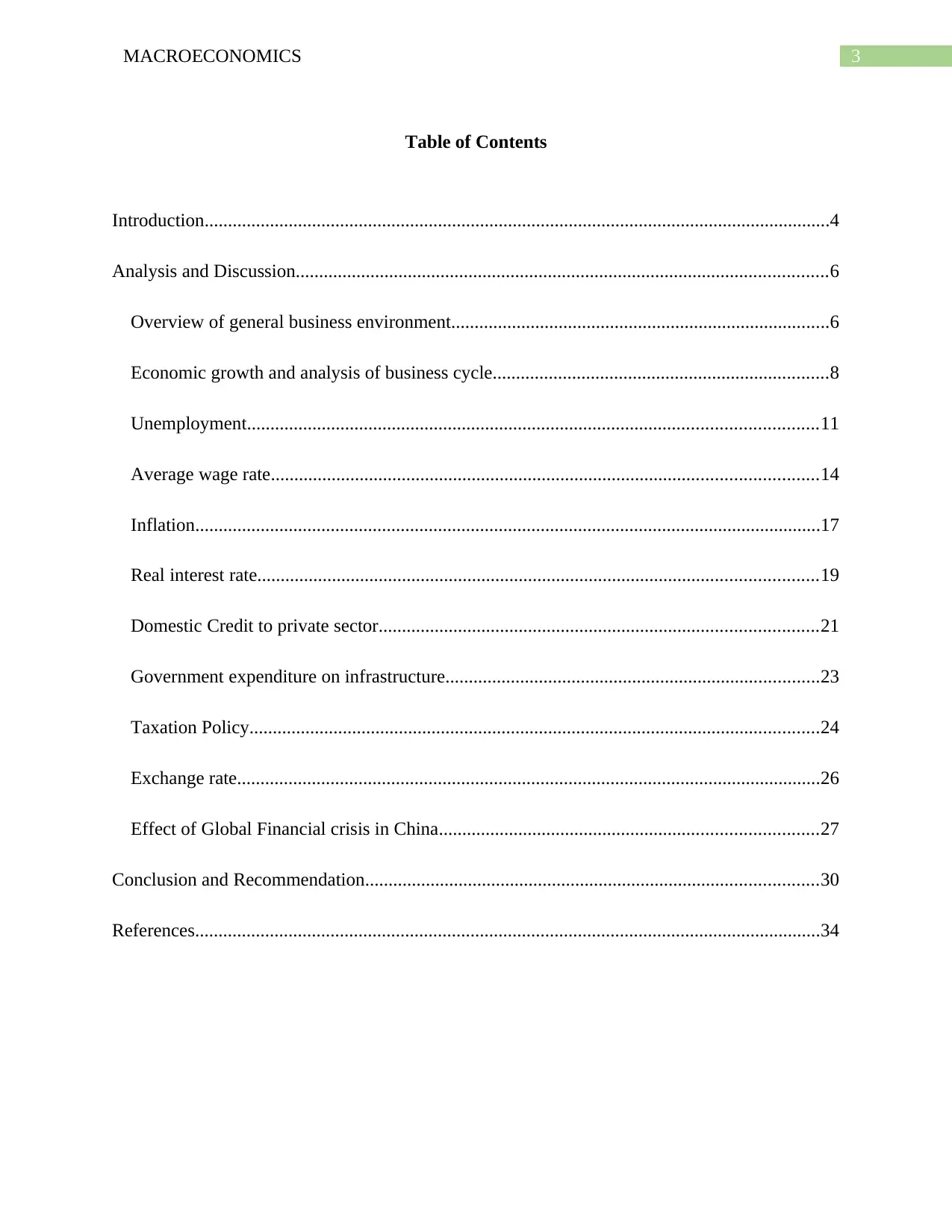
3MACROECONOMICS
Table of Contents
Introduction......................................................................................................................................4
Analysis and Discussion..................................................................................................................6
Overview of general business environment.................................................................................6
Economic growth and analysis of business cycle........................................................................8
Unemployment..........................................................................................................................11
Average wage rate.....................................................................................................................14
Inflation......................................................................................................................................17
Real interest rate........................................................................................................................19
Domestic Credit to private sector..............................................................................................21
Government expenditure on infrastructure................................................................................23
Taxation Policy..........................................................................................................................24
Exchange rate.............................................................................................................................26
Effect of Global Financial crisis in China.................................................................................27
Conclusion and Recommendation.................................................................................................30
References......................................................................................................................................34
Table of Contents
Introduction......................................................................................................................................4
Analysis and Discussion..................................................................................................................6
Overview of general business environment.................................................................................6
Economic growth and analysis of business cycle........................................................................8
Unemployment..........................................................................................................................11
Average wage rate.....................................................................................................................14
Inflation......................................................................................................................................17
Real interest rate........................................................................................................................19
Domestic Credit to private sector..............................................................................................21
Government expenditure on infrastructure................................................................................23
Taxation Policy..........................................................................................................................24
Exchange rate.............................................................................................................................26
Effect of Global Financial crisis in China.................................................................................27
Conclusion and Recommendation.................................................................................................30
References......................................................................................................................................34
Paraphrase This Document
Need a fresh take? Get an instant paraphrase of this document with our AI Paraphraser
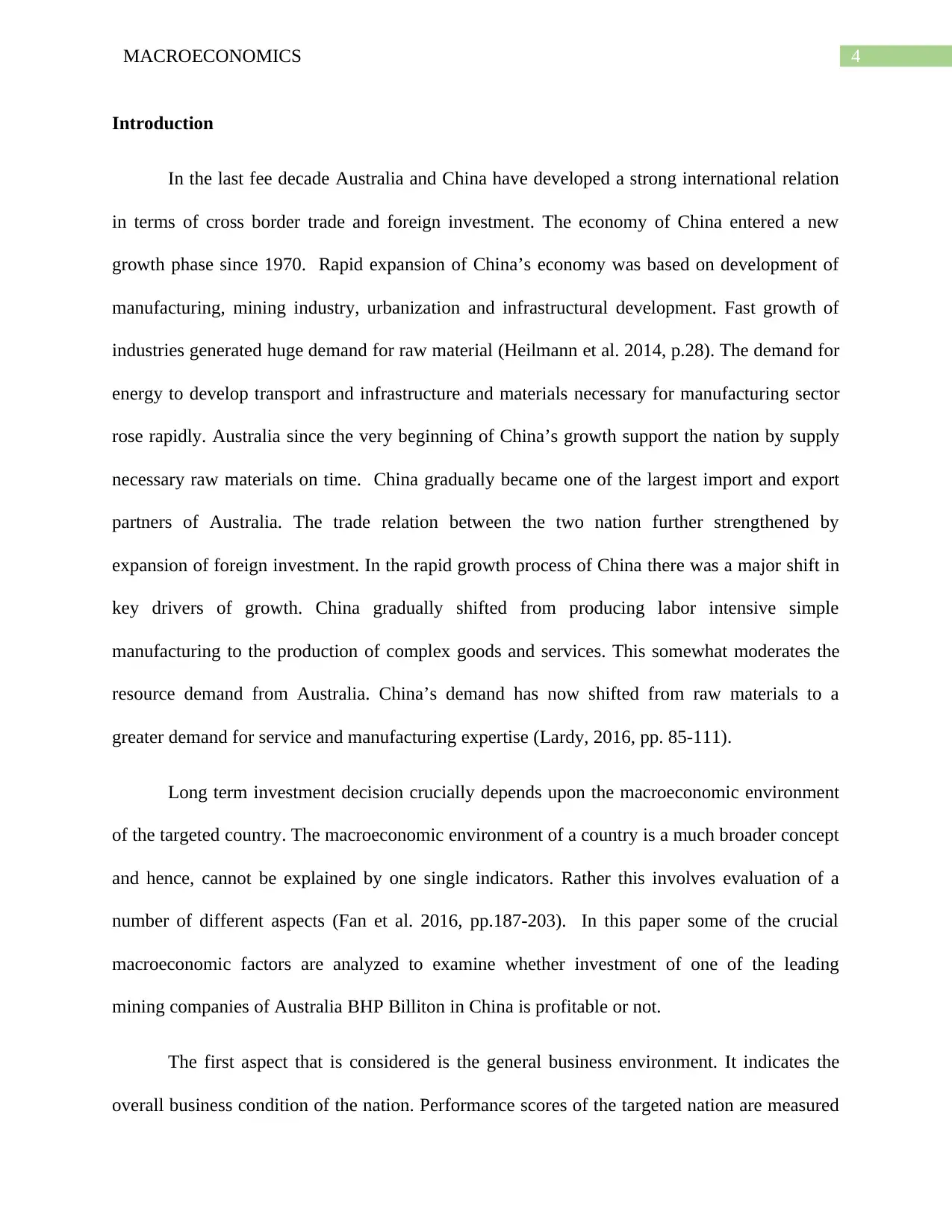
4MACROECONOMICS
Introduction
In the last fee decade Australia and China have developed a strong international relation
in terms of cross border trade and foreign investment. The economy of China entered a new
growth phase since 1970. Rapid expansion of China’s economy was based on development of
manufacturing, mining industry, urbanization and infrastructural development. Fast growth of
industries generated huge demand for raw material (Heilmann et al. 2014, p.28). The demand for
energy to develop transport and infrastructure and materials necessary for manufacturing sector
rose rapidly. Australia since the very beginning of China’s growth support the nation by supply
necessary raw materials on time. China gradually became one of the largest import and export
partners of Australia. The trade relation between the two nation further strengthened by
expansion of foreign investment. In the rapid growth process of China there was a major shift in
key drivers of growth. China gradually shifted from producing labor intensive simple
manufacturing to the production of complex goods and services. This somewhat moderates the
resource demand from Australia. China’s demand has now shifted from raw materials to a
greater demand for service and manufacturing expertise (Lardy, 2016, pp. 85-111).
Long term investment decision crucially depends upon the macroeconomic environment
of the targeted country. The macroeconomic environment of a country is a much broader concept
and hence, cannot be explained by one single indicators. Rather this involves evaluation of a
number of different aspects (Fan et al. 2016, pp.187-203). In this paper some of the crucial
macroeconomic factors are analyzed to examine whether investment of one of the leading
mining companies of Australia BHP Billiton in China is profitable or not.
The first aspect that is considered is the general business environment. It indicates the
overall business condition of the nation. Performance scores of the targeted nation are measured
Introduction
In the last fee decade Australia and China have developed a strong international relation
in terms of cross border trade and foreign investment. The economy of China entered a new
growth phase since 1970. Rapid expansion of China’s economy was based on development of
manufacturing, mining industry, urbanization and infrastructural development. Fast growth of
industries generated huge demand for raw material (Heilmann et al. 2014, p.28). The demand for
energy to develop transport and infrastructure and materials necessary for manufacturing sector
rose rapidly. Australia since the very beginning of China’s growth support the nation by supply
necessary raw materials on time. China gradually became one of the largest import and export
partners of Australia. The trade relation between the two nation further strengthened by
expansion of foreign investment. In the rapid growth process of China there was a major shift in
key drivers of growth. China gradually shifted from producing labor intensive simple
manufacturing to the production of complex goods and services. This somewhat moderates the
resource demand from Australia. China’s demand has now shifted from raw materials to a
greater demand for service and manufacturing expertise (Lardy, 2016, pp. 85-111).
Long term investment decision crucially depends upon the macroeconomic environment
of the targeted country. The macroeconomic environment of a country is a much broader concept
and hence, cannot be explained by one single indicators. Rather this involves evaluation of a
number of different aspects (Fan et al. 2016, pp.187-203). In this paper some of the crucial
macroeconomic factors are analyzed to examine whether investment of one of the leading
mining companies of Australia BHP Billiton in China is profitable or not.
The first aspect that is considered is the general business environment. It indicates the
overall business condition of the nation. Performance scores of the targeted nation are measured
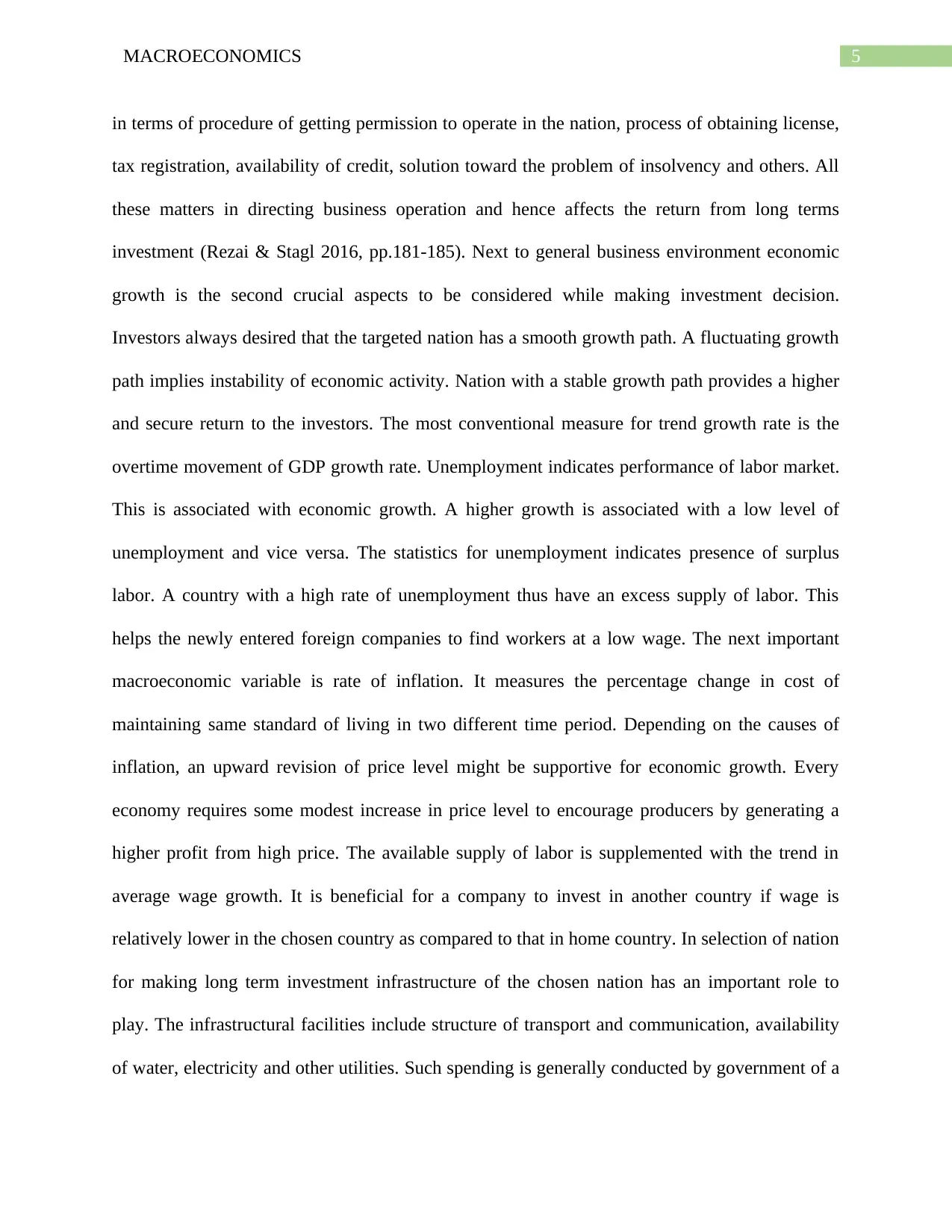
5MACROECONOMICS
in terms of procedure of getting permission to operate in the nation, process of obtaining license,
tax registration, availability of credit, solution toward the problem of insolvency and others. All
these matters in directing business operation and hence affects the return from long terms
investment (Rezai & Stagl 2016, pp.181-185). Next to general business environment economic
growth is the second crucial aspects to be considered while making investment decision.
Investors always desired that the targeted nation has a smooth growth path. A fluctuating growth
path implies instability of economic activity. Nation with a stable growth path provides a higher
and secure return to the investors. The most conventional measure for trend growth rate is the
overtime movement of GDP growth rate. Unemployment indicates performance of labor market.
This is associated with economic growth. A higher growth is associated with a low level of
unemployment and vice versa. The statistics for unemployment indicates presence of surplus
labor. A country with a high rate of unemployment thus have an excess supply of labor. This
helps the newly entered foreign companies to find workers at a low wage. The next important
macroeconomic variable is rate of inflation. It measures the percentage change in cost of
maintaining same standard of living in two different time period. Depending on the causes of
inflation, an upward revision of price level might be supportive for economic growth. Every
economy requires some modest increase in price level to encourage producers by generating a
higher profit from high price. The available supply of labor is supplemented with the trend in
average wage growth. It is beneficial for a company to invest in another country if wage is
relatively lower in the chosen country as compared to that in home country. In selection of nation
for making long term investment infrastructure of the chosen nation has an important role to
play. The infrastructural facilities include structure of transport and communication, availability
of water, electricity and other utilities. Such spending is generally conducted by government of a
in terms of procedure of getting permission to operate in the nation, process of obtaining license,
tax registration, availability of credit, solution toward the problem of insolvency and others. All
these matters in directing business operation and hence affects the return from long terms
investment (Rezai & Stagl 2016, pp.181-185). Next to general business environment economic
growth is the second crucial aspects to be considered while making investment decision.
Investors always desired that the targeted nation has a smooth growth path. A fluctuating growth
path implies instability of economic activity. Nation with a stable growth path provides a higher
and secure return to the investors. The most conventional measure for trend growth rate is the
overtime movement of GDP growth rate. Unemployment indicates performance of labor market.
This is associated with economic growth. A higher growth is associated with a low level of
unemployment and vice versa. The statistics for unemployment indicates presence of surplus
labor. A country with a high rate of unemployment thus have an excess supply of labor. This
helps the newly entered foreign companies to find workers at a low wage. The next important
macroeconomic variable is rate of inflation. It measures the percentage change in cost of
maintaining same standard of living in two different time period. Depending on the causes of
inflation, an upward revision of price level might be supportive for economic growth. Every
economy requires some modest increase in price level to encourage producers by generating a
higher profit from high price. The available supply of labor is supplemented with the trend in
average wage growth. It is beneficial for a company to invest in another country if wage is
relatively lower in the chosen country as compared to that in home country. In selection of nation
for making long term investment infrastructure of the chosen nation has an important role to
play. The infrastructural facilities include structure of transport and communication, availability
of water, electricity and other utilities. Such spending is generally conducted by government of a
⊘ This is a preview!⊘
Do you want full access?
Subscribe today to unlock all pages.

Trusted by 1+ million students worldwide
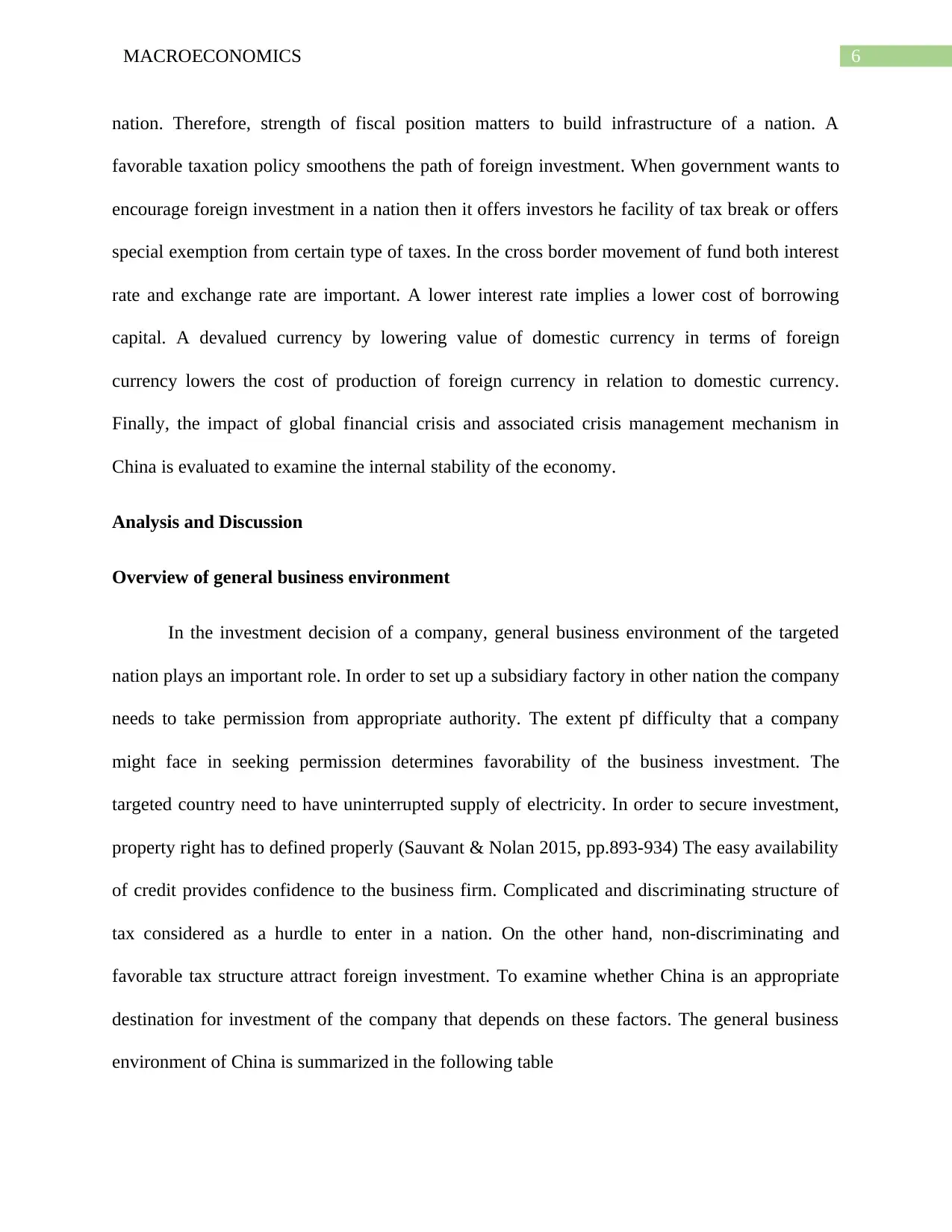
6MACROECONOMICS
nation. Therefore, strength of fiscal position matters to build infrastructure of a nation. A
favorable taxation policy smoothens the path of foreign investment. When government wants to
encourage foreign investment in a nation then it offers investors he facility of tax break or offers
special exemption from certain type of taxes. In the cross border movement of fund both interest
rate and exchange rate are important. A lower interest rate implies a lower cost of borrowing
capital. A devalued currency by lowering value of domestic currency in terms of foreign
currency lowers the cost of production of foreign currency in relation to domestic currency.
Finally, the impact of global financial crisis and associated crisis management mechanism in
China is evaluated to examine the internal stability of the economy.
Analysis and Discussion
Overview of general business environment
In the investment decision of a company, general business environment of the targeted
nation plays an important role. In order to set up a subsidiary factory in other nation the company
needs to take permission from appropriate authority. The extent pf difficulty that a company
might face in seeking permission determines favorability of the business investment. The
targeted country need to have uninterrupted supply of electricity. In order to secure investment,
property right has to defined properly (Sauvant & Nolan 2015, pp.893-934) The easy availability
of credit provides confidence to the business firm. Complicated and discriminating structure of
tax considered as a hurdle to enter in a nation. On the other hand, non-discriminating and
favorable tax structure attract foreign investment. To examine whether China is an appropriate
destination for investment of the company that depends on these factors. The general business
environment of China is summarized in the following table
nation. Therefore, strength of fiscal position matters to build infrastructure of a nation. A
favorable taxation policy smoothens the path of foreign investment. When government wants to
encourage foreign investment in a nation then it offers investors he facility of tax break or offers
special exemption from certain type of taxes. In the cross border movement of fund both interest
rate and exchange rate are important. A lower interest rate implies a lower cost of borrowing
capital. A devalued currency by lowering value of domestic currency in terms of foreign
currency lowers the cost of production of foreign currency in relation to domestic currency.
Finally, the impact of global financial crisis and associated crisis management mechanism in
China is evaluated to examine the internal stability of the economy.
Analysis and Discussion
Overview of general business environment
In the investment decision of a company, general business environment of the targeted
nation plays an important role. In order to set up a subsidiary factory in other nation the company
needs to take permission from appropriate authority. The extent pf difficulty that a company
might face in seeking permission determines favorability of the business investment. The
targeted country need to have uninterrupted supply of electricity. In order to secure investment,
property right has to defined properly (Sauvant & Nolan 2015, pp.893-934) The easy availability
of credit provides confidence to the business firm. Complicated and discriminating structure of
tax considered as a hurdle to enter in a nation. On the other hand, non-discriminating and
favorable tax structure attract foreign investment. To examine whether China is an appropriate
destination for investment of the company that depends on these factors. The general business
environment of China is summarized in the following table
Paraphrase This Document
Need a fresh take? Get an instant paraphrase of this document with our AI Paraphraser
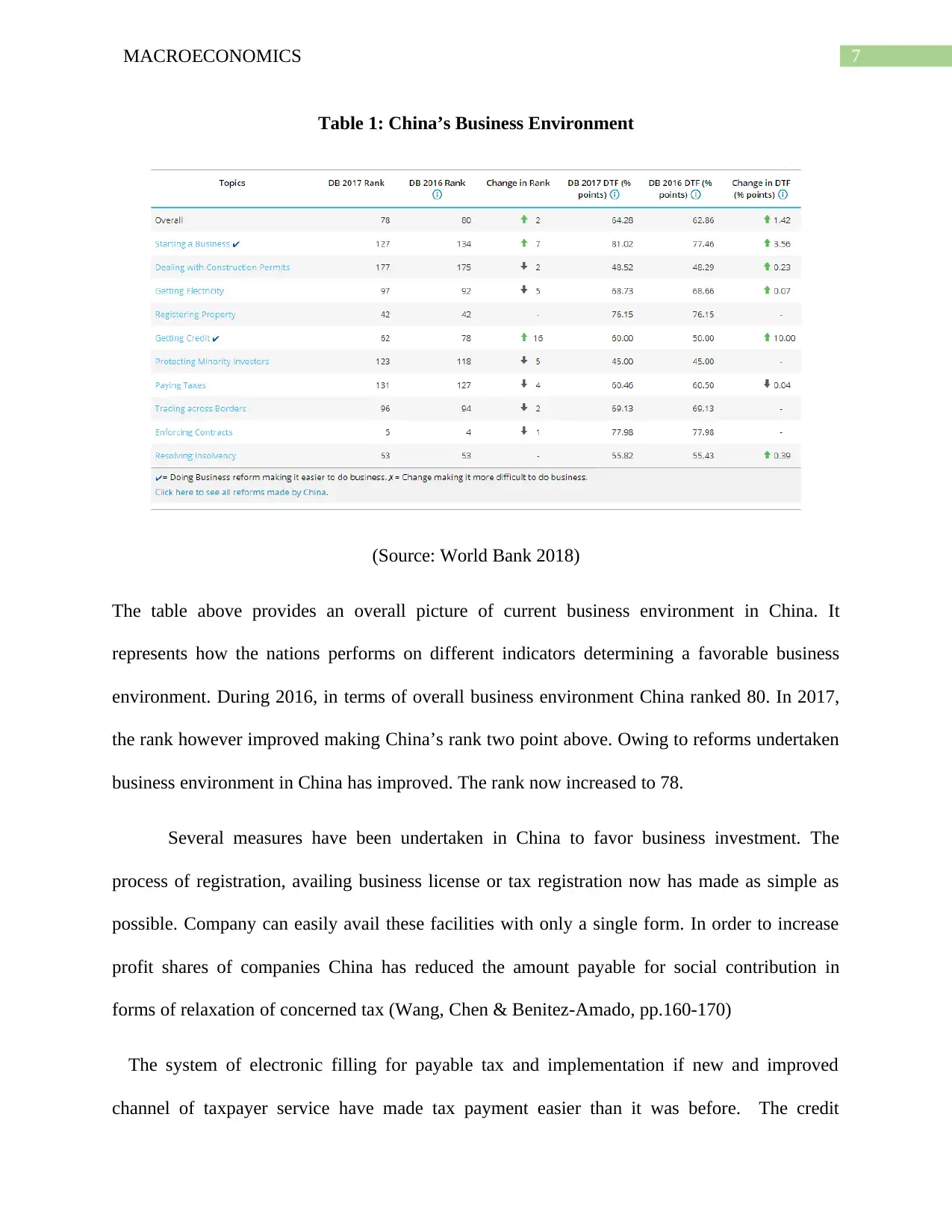
7MACROECONOMICS
Table 1: China’s Business Environment
(Source: World Bank 2018)
The table above provides an overall picture of current business environment in China. It
represents how the nations performs on different indicators determining a favorable business
environment. During 2016, in terms of overall business environment China ranked 80. In 2017,
the rank however improved making China’s rank two point above. Owing to reforms undertaken
business environment in China has improved. The rank now increased to 78.
Several measures have been undertaken in China to favor business investment. The
process of registration, availing business license or tax registration now has made as simple as
possible. Company can easily avail these facilities with only a single form. In order to increase
profit shares of companies China has reduced the amount payable for social contribution in
forms of relaxation of concerned tax (Wang, Chen & Benitez-Amado, pp.160-170)
The system of electronic filling for payable tax and implementation if new and improved
channel of taxpayer service have made tax payment easier than it was before. The credit
Table 1: China’s Business Environment
(Source: World Bank 2018)
The table above provides an overall picture of current business environment in China. It
represents how the nations performs on different indicators determining a favorable business
environment. During 2016, in terms of overall business environment China ranked 80. In 2017,
the rank however improved making China’s rank two point above. Owing to reforms undertaken
business environment in China has improved. The rank now increased to 78.
Several measures have been undertaken in China to favor business investment. The
process of registration, availing business license or tax registration now has made as simple as
possible. Company can easily avail these facilities with only a single form. In order to increase
profit shares of companies China has reduced the amount payable for social contribution in
forms of relaxation of concerned tax (Wang, Chen & Benitez-Amado, pp.160-170)
The system of electronic filling for payable tax and implementation if new and improved
channel of taxpayer service have made tax payment easier than it was before. The credit
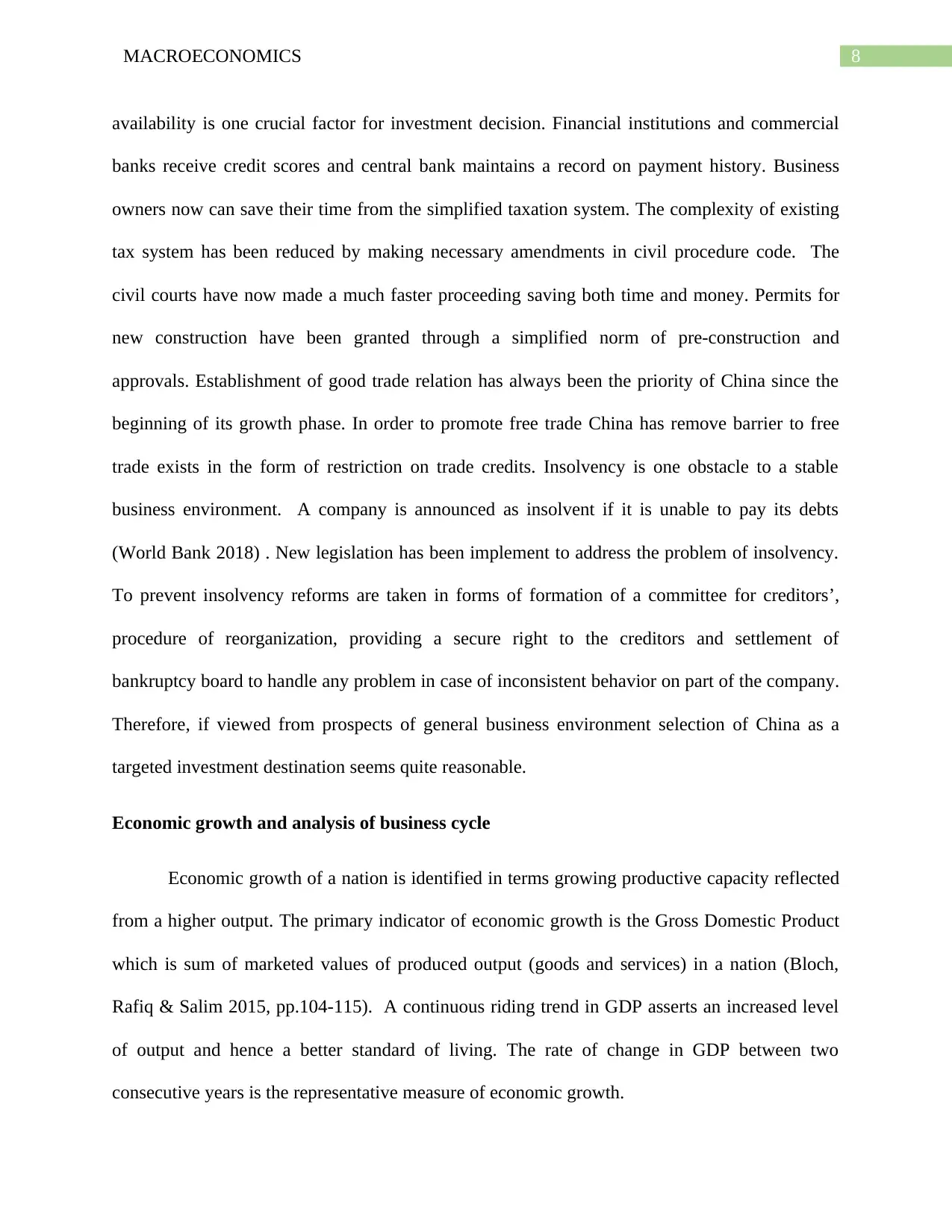
8MACROECONOMICS
availability is one crucial factor for investment decision. Financial institutions and commercial
banks receive credit scores and central bank maintains a record on payment history. Business
owners now can save their time from the simplified taxation system. The complexity of existing
tax system has been reduced by making necessary amendments in civil procedure code. The
civil courts have now made a much faster proceeding saving both time and money. Permits for
new construction have been granted through a simplified norm of pre-construction and
approvals. Establishment of good trade relation has always been the priority of China since the
beginning of its growth phase. In order to promote free trade China has remove barrier to free
trade exists in the form of restriction on trade credits. Insolvency is one obstacle to a stable
business environment. A company is announced as insolvent if it is unable to pay its debts
(World Bank 2018) . New legislation has been implement to address the problem of insolvency.
To prevent insolvency reforms are taken in forms of formation of a committee for creditors’,
procedure of reorganization, providing a secure right to the creditors and settlement of
bankruptcy board to handle any problem in case of inconsistent behavior on part of the company.
Therefore, if viewed from prospects of general business environment selection of China as a
targeted investment destination seems quite reasonable.
Economic growth and analysis of business cycle
Economic growth of a nation is identified in terms growing productive capacity reflected
from a higher output. The primary indicator of economic growth is the Gross Domestic Product
which is sum of marketed values of produced output (goods and services) in a nation (Bloch,
Rafiq & Salim 2015, pp.104-115). A continuous riding trend in GDP asserts an increased level
of output and hence a better standard of living. The rate of change in GDP between two
consecutive years is the representative measure of economic growth.
availability is one crucial factor for investment decision. Financial institutions and commercial
banks receive credit scores and central bank maintains a record on payment history. Business
owners now can save their time from the simplified taxation system. The complexity of existing
tax system has been reduced by making necessary amendments in civil procedure code. The
civil courts have now made a much faster proceeding saving both time and money. Permits for
new construction have been granted through a simplified norm of pre-construction and
approvals. Establishment of good trade relation has always been the priority of China since the
beginning of its growth phase. In order to promote free trade China has remove barrier to free
trade exists in the form of restriction on trade credits. Insolvency is one obstacle to a stable
business environment. A company is announced as insolvent if it is unable to pay its debts
(World Bank 2018) . New legislation has been implement to address the problem of insolvency.
To prevent insolvency reforms are taken in forms of formation of a committee for creditors’,
procedure of reorganization, providing a secure right to the creditors and settlement of
bankruptcy board to handle any problem in case of inconsistent behavior on part of the company.
Therefore, if viewed from prospects of general business environment selection of China as a
targeted investment destination seems quite reasonable.
Economic growth and analysis of business cycle
Economic growth of a nation is identified in terms growing productive capacity reflected
from a higher output. The primary indicator of economic growth is the Gross Domestic Product
which is sum of marketed values of produced output (goods and services) in a nation (Bloch,
Rafiq & Salim 2015, pp.104-115). A continuous riding trend in GDP asserts an increased level
of output and hence a better standard of living. The rate of change in GDP between two
consecutive years is the representative measure of economic growth.
⊘ This is a preview!⊘
Do you want full access?
Subscribe today to unlock all pages.

Trusted by 1+ million students worldwide
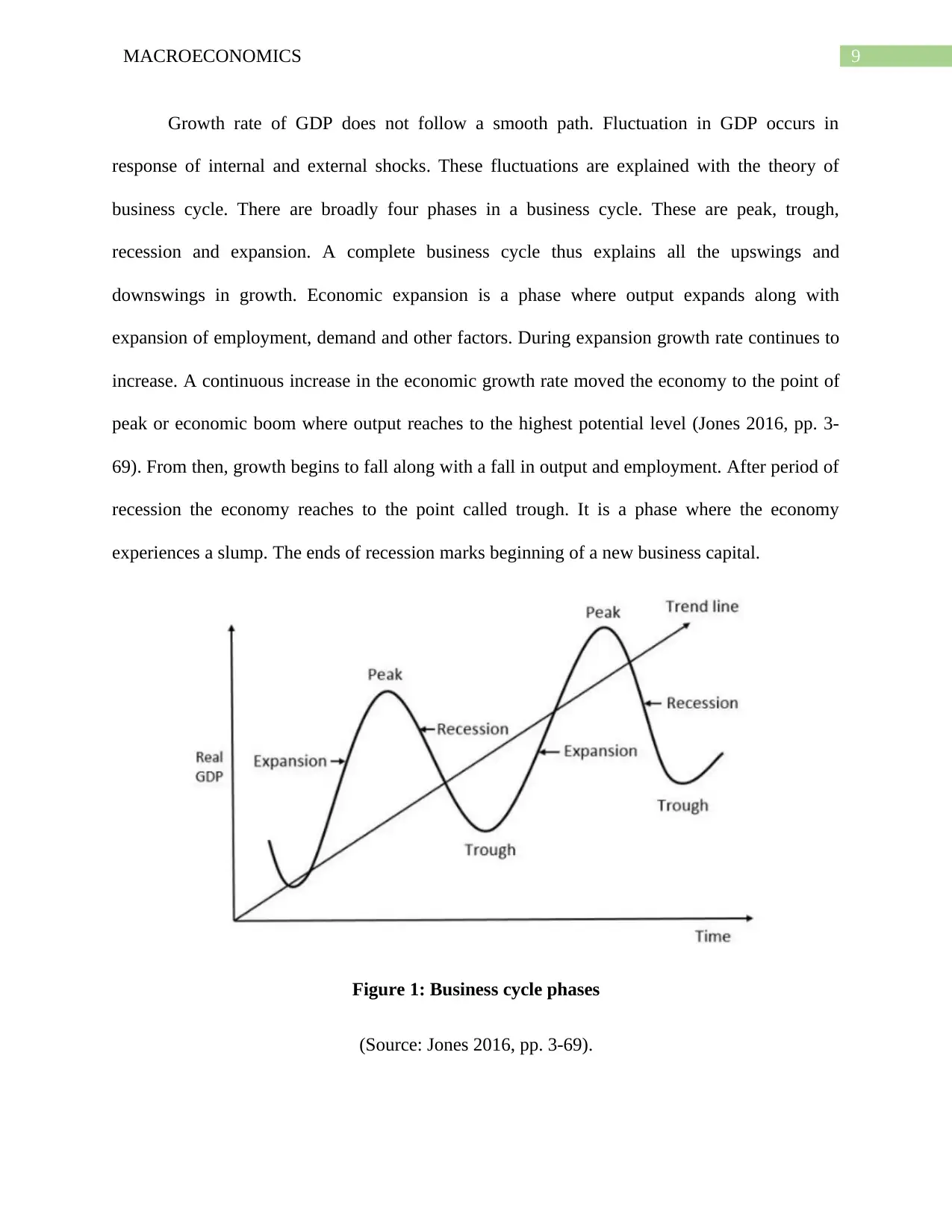
9MACROECONOMICS
Growth rate of GDP does not follow a smooth path. Fluctuation in GDP occurs in
response of internal and external shocks. These fluctuations are explained with the theory of
business cycle. There are broadly four phases in a business cycle. These are peak, trough,
recession and expansion. A complete business cycle thus explains all the upswings and
downswings in growth. Economic expansion is a phase where output expands along with
expansion of employment, demand and other factors. During expansion growth rate continues to
increase. A continuous increase in the economic growth rate moved the economy to the point of
peak or economic boom where output reaches to the highest potential level (Jones 2016, pp. 3-
69). From then, growth begins to fall along with a fall in output and employment. After period of
recession the economy reaches to the point called trough. It is a phase where the economy
experiences a slump. The ends of recession marks beginning of a new business capital.
Figure 1: Business cycle phases
(Source: Jones 2016, pp. 3-69).
Growth rate of GDP does not follow a smooth path. Fluctuation in GDP occurs in
response of internal and external shocks. These fluctuations are explained with the theory of
business cycle. There are broadly four phases in a business cycle. These are peak, trough,
recession and expansion. A complete business cycle thus explains all the upswings and
downswings in growth. Economic expansion is a phase where output expands along with
expansion of employment, demand and other factors. During expansion growth rate continues to
increase. A continuous increase in the economic growth rate moved the economy to the point of
peak or economic boom where output reaches to the highest potential level (Jones 2016, pp. 3-
69). From then, growth begins to fall along with a fall in output and employment. After period of
recession the economy reaches to the point called trough. It is a phase where the economy
experiences a slump. The ends of recession marks beginning of a new business capital.
Figure 1: Business cycle phases
(Source: Jones 2016, pp. 3-69).
Paraphrase This Document
Need a fresh take? Get an instant paraphrase of this document with our AI Paraphraser
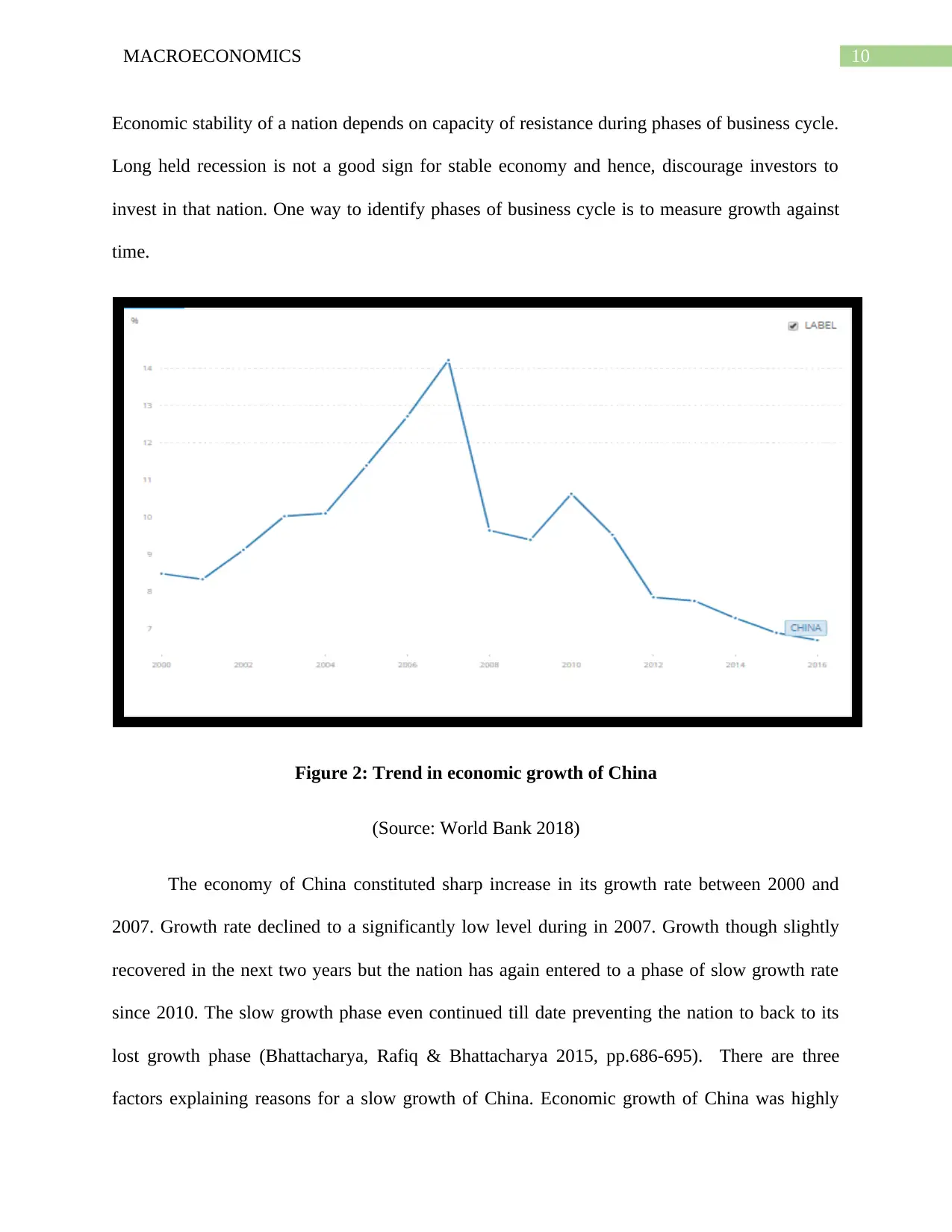
10MACROECONOMICS
Economic stability of a nation depends on capacity of resistance during phases of business cycle.
Long held recession is not a good sign for stable economy and hence, discourage investors to
invest in that nation. One way to identify phases of business cycle is to measure growth against
time.
Figure 2: Trend in economic growth of China
(Source: World Bank 2018)
The economy of China constituted sharp increase in its growth rate between 2000 and
2007. Growth rate declined to a significantly low level during in 2007. Growth though slightly
recovered in the next two years but the nation has again entered to a phase of slow growth rate
since 2010. The slow growth phase even continued till date preventing the nation to back to its
lost growth phase (Bhattacharya, Rafiq & Bhattacharya 2015, pp.686-695). There are three
factors explaining reasons for a slow growth of China. Economic growth of China was highly
Economic stability of a nation depends on capacity of resistance during phases of business cycle.
Long held recession is not a good sign for stable economy and hence, discourage investors to
invest in that nation. One way to identify phases of business cycle is to measure growth against
time.
Figure 2: Trend in economic growth of China
(Source: World Bank 2018)
The economy of China constituted sharp increase in its growth rate between 2000 and
2007. Growth rate declined to a significantly low level during in 2007. Growth though slightly
recovered in the next two years but the nation has again entered to a phase of slow growth rate
since 2010. The slow growth phase even continued till date preventing the nation to back to its
lost growth phase (Bhattacharya, Rafiq & Bhattacharya 2015, pp.686-695). There are three
factors explaining reasons for a slow growth of China. Economic growth of China was highly
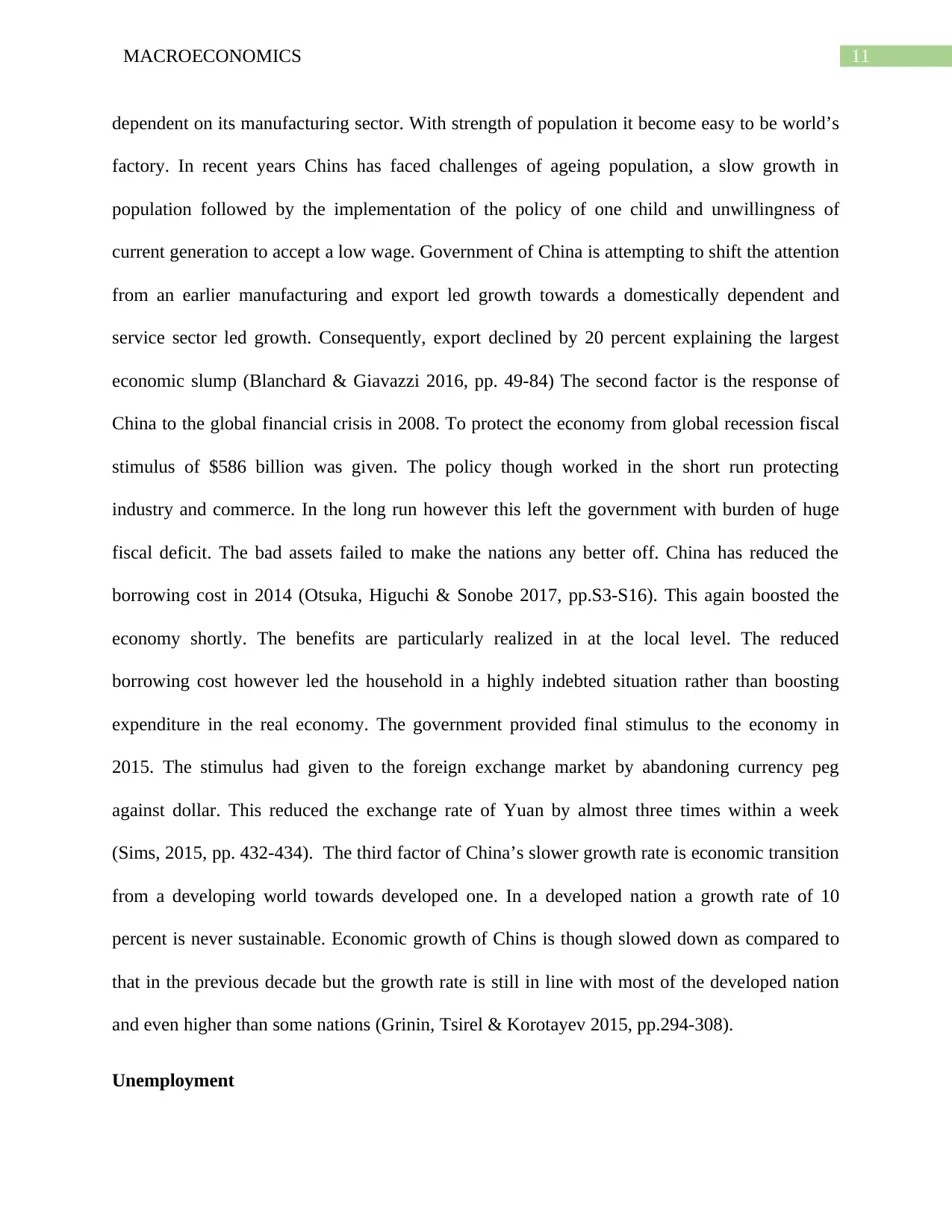
11MACROECONOMICS
dependent on its manufacturing sector. With strength of population it become easy to be world’s
factory. In recent years Chins has faced challenges of ageing population, a slow growth in
population followed by the implementation of the policy of one child and unwillingness of
current generation to accept a low wage. Government of China is attempting to shift the attention
from an earlier manufacturing and export led growth towards a domestically dependent and
service sector led growth. Consequently, export declined by 20 percent explaining the largest
economic slump (Blanchard & Giavazzi 2016, pp. 49-84) The second factor is the response of
China to the global financial crisis in 2008. To protect the economy from global recession fiscal
stimulus of $586 billion was given. The policy though worked in the short run protecting
industry and commerce. In the long run however this left the government with burden of huge
fiscal deficit. The bad assets failed to make the nations any better off. China has reduced the
borrowing cost in 2014 (Otsuka, Higuchi & Sonobe 2017, pp.S3-S16). This again boosted the
economy shortly. The benefits are particularly realized in at the local level. The reduced
borrowing cost however led the household in a highly indebted situation rather than boosting
expenditure in the real economy. The government provided final stimulus to the economy in
2015. The stimulus had given to the foreign exchange market by abandoning currency peg
against dollar. This reduced the exchange rate of Yuan by almost three times within a week
(Sims, 2015, pp. 432-434). The third factor of China’s slower growth rate is economic transition
from a developing world towards developed one. In a developed nation a growth rate of 10
percent is never sustainable. Economic growth of Chins is though slowed down as compared to
that in the previous decade but the growth rate is still in line with most of the developed nation
and even higher than some nations (Grinin, Tsirel & Korotayev 2015, pp.294-308).
Unemployment
dependent on its manufacturing sector. With strength of population it become easy to be world’s
factory. In recent years Chins has faced challenges of ageing population, a slow growth in
population followed by the implementation of the policy of one child and unwillingness of
current generation to accept a low wage. Government of China is attempting to shift the attention
from an earlier manufacturing and export led growth towards a domestically dependent and
service sector led growth. Consequently, export declined by 20 percent explaining the largest
economic slump (Blanchard & Giavazzi 2016, pp. 49-84) The second factor is the response of
China to the global financial crisis in 2008. To protect the economy from global recession fiscal
stimulus of $586 billion was given. The policy though worked in the short run protecting
industry and commerce. In the long run however this left the government with burden of huge
fiscal deficit. The bad assets failed to make the nations any better off. China has reduced the
borrowing cost in 2014 (Otsuka, Higuchi & Sonobe 2017, pp.S3-S16). This again boosted the
economy shortly. The benefits are particularly realized in at the local level. The reduced
borrowing cost however led the household in a highly indebted situation rather than boosting
expenditure in the real economy. The government provided final stimulus to the economy in
2015. The stimulus had given to the foreign exchange market by abandoning currency peg
against dollar. This reduced the exchange rate of Yuan by almost three times within a week
(Sims, 2015, pp. 432-434). The third factor of China’s slower growth rate is economic transition
from a developing world towards developed one. In a developed nation a growth rate of 10
percent is never sustainable. Economic growth of Chins is though slowed down as compared to
that in the previous decade but the growth rate is still in line with most of the developed nation
and even higher than some nations (Grinin, Tsirel & Korotayev 2015, pp.294-308).
Unemployment
⊘ This is a preview!⊘
Do you want full access?
Subscribe today to unlock all pages.

Trusted by 1+ million students worldwide
1 out of 41
Related Documents
Your All-in-One AI-Powered Toolkit for Academic Success.
+13062052269
info@desklib.com
Available 24*7 on WhatsApp / Email
![[object Object]](/_next/static/media/star-bottom.7253800d.svg)
Unlock your academic potential
Copyright © 2020–2025 A2Z Services. All Rights Reserved. Developed and managed by ZUCOL.





